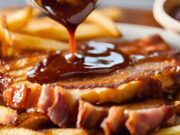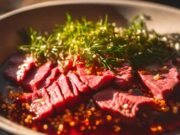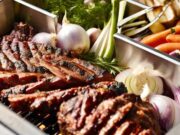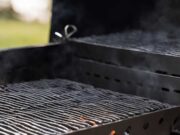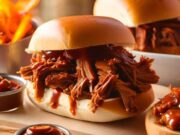- Key Takeaways:
- Overview of Popular BBQ Woods
- Hickory: A Classic Choice for Bold Flavor
- Mesquite: The Southwestern Favorite
- Oak: The Time-Tested Favorite
- Fruitwoods: Adding a Touch of Sweetness
- Pecan: The Perfect Balance
- Choosing the Right Wood for Different Meats
- Combining Woods for a Unique Flavor
- Tips for Preparing Your Wood
- Frequently Asked Questions
When it comes to BBQ, the choice of wood can significantly impact your culinary experience. Each type of wood offers a unique flavor profile that enhances the meats and adds depth to your dishes.
From the robust flavor of hickory to the subtle sweetness of fruitwoods, understanding the characteristics of different woods is essential for any grilling enthusiast.
This guide will provide insights into popular BBQ woods, tips for selecting the ideal one, and instructions on how to prepare it for a delectable smoke.
Key Takeaways:
- Choose the right wood for your BBQ to enhance flavor and create a unique taste experience.
- Hickory, mesquite, oak, and fruitwoods offer distinct flavors that can be combined for a perfect balance.
- Consider the type of meat being smoked and prepare the wood properly for optimal results.
Overview of Popular BBQ Woods
In the realm of BBQ, certain woods are considered superior due to their unique characteristics and flavor contributions. For instance, hickory wood is well-known for its robust, bold flavors, while mesquite wood is particularly popular in the American Southwest for its intense smokiness.
Oak wood stands out for its versatility and reliability, making it a staple among barbecue enthusiasts. Furthermore, fruitwoods like apple and cherry introduce a distinctive sweetness that enhances the overall smoking experience, creating a balanced flavor profile that pairs exceptionally well with various meats.
Beyond these familiar choices, the selection of smoking wood can have a profound impact on the texture and aroma of grilled dishes. For example, pecan wood provides a rich and slightly sweet profile, serving as a milder option that complements poultry and pork beautifully.
In contrast, woods such as alder are favored for fish, imparting a delicate, subtly sweet flavor that enhances the natural taste of seafood.

Exploring different smoking woods not only enriches your culinary journey but also deepens your appreciation for the time-honored traditions of barbecue, where mastery of flavor profiles distinguishes skilled pitmasters.
Hickory: A Classic Choice for Bold Flavor
Hickory wood is a standout choice among barbecue enthusiasts, renowned for its bold flavor and versatility in smoking techniques. This wood type imparts a robust smoky aroma that can elevate any cut of meat, making it particularly popular for smoking brisket. Its distinctive flavor provides a rich balance of smokiness and tenderness, complementing the natural flavors of pork and chicken effectively.
As many pitmasters emphasize, hickory’s consistent presence in smoking adds complexity to the cooking process, creating a delightful layer of flavor that enhances the overall experience. Managing the intensity of smokiness is crucial due to its strong characteristics; for instance, blending hickory with milder woods like apple or cherry can help temper its assertiveness.
Additionally, controlling the burn rate and selecting the appropriate amount of wood chips versus chunks can further refine your smoking journey.
Those who incorporate hickory into their culinary practices often find its remarkable ability to infuse meats with a pleasantly sweet, nutty undertone, making it a staple in the toolkit of many seasoned grillers.
Mesquite: The Southwestern Favorite
Mesquite wood is highly regarded in Southwestern barbecue culture for its strong flavor and distinctive smoky taste, which can impart a unique character to smoked meats. While its robust profile pairs exceptionally well with beef, many pitmasters advise using mesquite in moderation to prevent the flavor from overpowering the dish, making it an essential element in various smoking techniques.
This wood not only enhances meats like brisket and ribs but also complements game meats, enriching them with an earthy depth that accentuates their natural flavors. When smoking, it is advisable to combine mesquite with milder woods such as pecan or cherry to achieve a balanced flavor profile and avoid excessive intensity.
Mastering the use of mesquite involves controlling the smoke output, allowing for a gradual infusion that elevates the overall barbecue experience. Renowned for its cultural significance, mesquite has become synonymous with Tex-Mex cuisine, adding a distinct Southwestern flair to backyard barbecues. Understanding its unique characteristics ensures that each meal is not only delicious but also rooted in tradition.
Oak: The Time-Tested Favorite
Oak wood has long been considered a reliable favorite among barbecue enthusiasts, appreciated for its balanced flavor and versatility across various cooking methods. This type of wood delivers a mild smokiness that enhances the natural flavors of meats without overwhelming them, making it an excellent choice for smoking brisket, pork, and chicken.
Its rich and complex flavor profile pairs well with other woods such as hickory and mesquite, enabling you to create unique blends that cater to diverse tastes. When selecting oak wood for your barbecue, it is crucial to choose high-quality pieces that are free from rot, mold, and chemicals.
For optimal results, using seasoned oak logs or chunks that have been dried for at least six months will ensure a cleaner burn and a more enjoyable smoke flavor.
Maintaining a consistent smoking temperature and allowing sufficient time for the meat to absorb the oak’s essence will enhance your barbecue experience, making it truly memorable.
Red Oak vs. White Oak
When considering oak wood for smoking, you will often find yourself weighing the options between red oak and white oak, each offering distinct characteristics that can influence the smoking balance of your meats. Red oak is recognized for its strong flavor and is frequently preferred for smoking larger cuts of beef, while white oak provides a more delicate smokiness that complements a wide variety of meats, including chicken and pork.
This distinction is vital for anyone aiming to elevate their barbecue experience, as the choice of wood can dramatically alter the flavor profile of the final dish. Red oak tends to impart a robust smokiness with hints of spice, making it particularly suitable for heartier meats like brisket and ribs that can withstand its bold flavor. In contrast, white oak delivers a subtle sweetness that pairs beautifully with milder proteins, resulting in a balanced, nuanced taste that allows the natural flavors of the meat to shine.
Ultimately, the decision between these two types of oak comes down to personal preference and the specific type of meat being prepared, ensuring that each meal becomes a memorable culinary experience.
Fruitwoods: Adding a Touch of Sweetness
Fruitwoods such as apple wood and cherry wood are well-known for imparting a touch of sweetness to smoked meats, enhancing their flavor profiles with subtle sweetness and a delightful smoky essence. These woods are particularly favored for their ability to complement lighter meats, including poultry and pork, making them an excellent choice for barbecue enthusiasts seeking a distinctive smoking experience.
Plus apple and cherry, other fruitwoods like peach and plum also provide unique flavor nuances that elevate the barbecue experience. Peach wood contributes a mild sweetness that pairs exceptionally well with chicken, while plum wood offers a rich, fruity essence that can enhance cuts of beef and lamb.
When utilizing these fruitwoods, it is essential to experiment with different combinations and balance the smokiness to ensure the final dish does not overshadow the natural flavors of the meat. Achieving that perfect harmony can result in an unforgettable barbecue feast that showcases the subtle complexity of each fruitwood. Whether smoking ribs or brisket, employing fruitwoods can truly transform ordinary grilling sessions into gourmet culinary adventures.
Pecan: The Perfect Balance
Pecan wood provides a unique flavor profile that strikes an ideal balance between sweetness and a mild smoky taste, making it a preferred choice among pitmasters and barbecue enthusiasts. Its versatility enables it to enhance a range of smoked meats, from brisket to chicken, contributing to culinary excellence in BBQ.
This wood is particularly effective at complementing richer cuts, such as pork ribs and sausage, delivering a subtle sweetness that enhances the natural flavors of the meat. When you utilize it in various smoking techniques, whether in a traditional offset smoker or a pellet grill, pecan wood imparts its distinct characteristics effectively.
Many enthusiasts blend it with other woods like hickory or cherry to create a more complex smoke, allowing the meat’s flavor to shine while achieving an exceptional balance that keeps guests coming back for more.
Choosing the Right Wood for Different Meats
Selecting the appropriate wood for various types of meat is crucial for achieving the desired flavor and tenderness in your BBQ. By understanding the unique characteristics of each wood type, such as hickory, mesquite, and fruitwoods, you can effectively pair the right wood with your specific meats.
This knowledge significantly enhances your overall smoking experience and contributes to the quality of your barbecue.
Combining Woods for a Unique Flavor
Combining different types of wood can create a unique flavor profile that enhances the smoky taste of your BBQ. This allows you to experiment with various wood combinations to achieve the perfect balance. Techniques for blending woods, such as pairing hickory with fruitwoods or mesquite with oak, can unlock new dimensions of flavor and smokiness.
By understanding the distinct characteristics of each wood, you can tailor your smoking experience to match your individual preferences. For instance, fruitwoods like apple and cherry impart a mild, sweet essence, making them excellent companions for stronger woods.
Experimenting with different ratios, such as a 75-25 mix of hickory and apple, can create a balanced smokiness that highlights the natural flavors of the meat. Ensuring that your wood is properly seasoned will reduce bitterness and enhance the clean, aromatic smoke that is desired for barbecue.
Ultimately, the key lies in experimentation, allowing you to discover your perfect wood combination for unforgettable flavor.
Tips for Preparing Your Wood
Preparing your wood properly is a crucial step in the smoking process that can significantly impact the final outcome of your BBQ.
Best practices for wood preparation involve ensuring high wood quality, selecting the appropriate size of logs, chunks, or chips, and allowing the wood to season adequately to achieve optimal smoking characteristics.
Cutting and Splitting Wood
Cutting and splitting wood properly is essential for achieving the right size and type needed for optimal smoking. The size of the wood can significantly impact its burning rate and smoke characteristics. Ensuring uniformity in your wood chunks or logs promotes even burning and contributes to better smoke absorption, enhancing the overall flavor profile of your BBQ.
In terms of cutting, you can effectively utilize a saw or axe, depending on the type of wood and the volume required. For consistent results, aim for pieces that are approximately 1 to 4 inches thick; this size range tends to produce a robust smoke while allowing for adequate airflow during cooking.
Splitting wood is equally crucial and can be achieved with a splitting maul or a wedge for larger logs. This not only expedites the drying process, which is key to enhancing flavor, but also ensures that the wood ignites faster and burns more evenly.
Keep in mind that using seasoned wood will provide a cleaner burn and richer smoke flavor. Therefore, it is advisable to plan ahead and allow your wood ample time to dry before using it in your smoker or grill.
Frequently Asked Questions
What types of wood are commonly used for BBQ?
Hickory, mesquite, oak, cherry, apple, and pecan are all popular options for adding flavor to BBQ dishes.
What is the difference between hickory and mesquite wood?
Hickory wood has a strong, smoky flavor that is often described as bacon-like. Mesquite wood, on the other hand, has a sweeter, more intense flavor.
How do I choose the right wood for my BBQ?
The best wood for your BBQ will depend on personal preference and the type of meat you are cooking. For example, hickory is great for hearty meats like beef and pork, while fruit woods like cherry and apple pair well with poultry and fish.
Can I mix different types of wood when BBQing?
Yes, you can mix different types of wood to create unique flavor profiles. Just make sure to use a combination that complements the type of meat you are cooking.
How do I add wood flavor to my BBQ if I don’t have access to a wood-fired grill or smoker?
You can achieve a similar flavor by using wood chips or chunks in a charcoal or gas grill. Soak the wood in water for 30 minutes before placing it on the grill to prevent it from burning too quickly.
Are there any safety precautions I should take when using wood for my BBQ?
Yes, make sure to use wood that is specifically meant for cooking and avoid using any wood that has been treated or exposed to chemicals. Also, always follow proper safety guidelines when using a grill or smoker.








